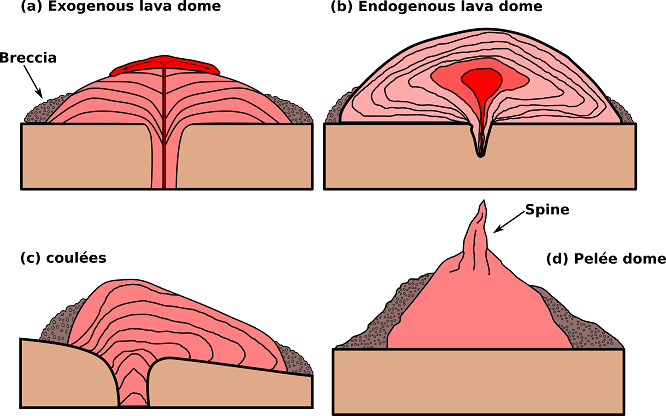Rhyolite
Rhyolite: A collective term for silicic volcanic rocks consisting of phenocrysts of quartz and alkali feldspar, often with minor plagioclase and biotite, in a microcrystalline or glassy groundmass and having the chemical composition of granite. The rock received its name from German geologist Ferdinand von Richthofen (better known as the Red Baron, a World War I, flying ace). The word rhyolite comes from the Greek word rhyax (stream) with the suffix "-ite" (rock).The rock's structure depends on the cooling rate when it formed. If the cooling process was slow, the rock may consist mostly of large, single phenocrysts, or it may be composed of a microcrystalline or even glass matrix. Phenocrysts typically include quartz, biotite, hornblende, pyroxene, feldspar, or amphibole. On the other hand, a quick cooling process produces glassy rhyolites, which include pumice, perlite, obsidian, and pitchstone. Explosive eruptions may produce tuff, tephra, and ignimbrites.
The higher level of SiO2 present in rhyolite melts, together with their lower temperatures of eruption, increases the viscosity of such melts, especially when crystallization has progressed to an advanced degree prior to eruption. Because of these factors, rhyolite lavas erupt as thick domes constructed directly over the volcanic vent.
Exogenous and endogenous lava dome: Lava domes vary in size and shape depending upon the volatile content and rheology of the lava. They also vary in the manner in which they grow (Fig.1). Some domes grow by the accumulation of new lobes of lava extruded from summit vents. As well as covering the top of the dome, such lobes may ooze down the steeper flanks, forming coulées (French: lava flow) whose surfaces are pleated by distinctive arcuate ridges, called ogives, resembling large scale pahoehoe. This extrusive style of dome growth is described as exogenous (Latin: growing on the outside). On the other hand, many lava domes grow by inflation when fresh magma is intruded into the dome interior without breaking out on the surface. Such endogenous dome growth (Latin: growing from within) leads to the development of blocky or spiny tops and steep sides covered with talus shed from the over steepened slopes above. It is not uncommon for a lava dome to grow by both endogenous and exogenous mechanisms.

Fig.1: The four major types are lava dome. (a) Exogenous lava dome; (b) endogenous lava dome; (c) Coulées; (d) Peléean.
Rhyolites are responsible for violent volcanic eruptions. During these eruptions, the silica-rich magma is so viscous that it does not flow in a river of lava. Instead, the volcano is more likely to explosively eject material. The eruptions that produce rhyolite have occurred throughout geologic history and all over the world. Given the devastating nature of such eruptions, it is fortunate that they have been rare in recent history. Only three rhyolite eruptions have occurred since the beginning of the 20th century: the St. Andrew Strait volcano in Papua New Guinea (1953-1957), the Novarupta volcano in Alaska (1912), and Chaitén in Chile (2008). Other active volcanoes capable of producing rhyolite include those found in Iceland, Yellowstone in the United States, and Tambora in Indonesia.
.jpg)
Flow-banded rhyolite. From Emily Zawacki.
.jpg)
Porphyritic rhyolite from Yellowstone, Wyoming, USA. From James St. John.
.jpg)
Flow-banded rhyolite with mafic xenoliths. Vulcano, Aeolian Islands, north of Sicily, Italy. From Callan Bentley.
.jpg)
Flow-banded rhyolite. Paleoproterozoic, Argylla Formation, Australia. From Ian Withnall.
.jpg)
Lava dome, Mount St. Helens, USA. From Scientia Fantastica.
.jpg)
Lava dome with coulées, Cerro Chao, Andes. From Wikipedia.
.jpg)
Spine volcano dome, called the "Needle of Pelée" (300 m). 1902 eruption of Mount Pelée. From Jim Webster.
Bibliography
• Cox et al. (1979): The Interpretation of Igneous Rocks, George Allen and Unwin, London.
• Howie, R. A., Zussman, J., & Deer, W. (1992). An introduction to the rock-forming minerals (p. 696). Longman.
• Le Maitre, R. W., Streckeisen, A., Zanettin, B., Le Bas, M. J., Bonin, B., Bateman, P., & Lameyre, J. (2002). Igneous rocks. A classification and glossary of terms, 2. Cambridge University Press.
• Middlemost, E. A. (1986). Magmas and magmatic rocks: an introduction to igneous petrology.
• Shelley, D. (1993). Igneous and metamorphic rocks under the microscope: classification, textures, microstructures and mineral preferred-orientations.
• Vernon, R. H. & Clarke, G. L. (2008): Principles of Metamorphic Petrology. Cambridge University Press.


.jpg)
.jpg)
.jpg)
.jpg)
.jpg)
.jpg)
.jpg)
.jpg)
.jpg)
.jpg)
.jpg)
.jpg)
.jpg)
.jpg)
.jpg)
.jpg)
.jpg)
.jpg)
.jpg)
.jpg)
.jpg)
.jpg)
.jpg)
.jpg)
.jpg)
.jpg)
.jpg)
.jpg)
.jpg)
.jpg)
.jpg)
.jpg)
.jpg)
.jpg)
.jpg)
.jpg)
.jpg)